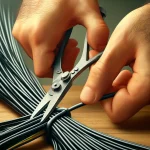Are you tired of struggling with stubborn cable ties that refuse to budge? Fear not! In this comprehensive guide, we'll delve into effective techniques for safely and easily removing cable ties without causing any damage. Whether you're a DIY enthusiast or a professional, mastering these techniques will make your projects smoother and more enjoyable.
Cable ties, also known as zip ties, are versatile fastening devices used in a wide range of applications, from securing cables and wires to organizing household items. While they're incredibly handy for holding things together, removing them can sometimes be a challenge. Fortunately, with the right approach, you can safely and efficiently remove cable ties without leaving behind any traces of damage.
Understanding Cable Ties Removal Techniques
Before we dive into specific techniques, let's first understand the basics of cable ties removal. Cable ties typically consist of a flexible strap and a ratcheting mechanism that locks the strap in place when tightened. To remove a cable tie, you'll need to release the ratchet and gently pull the strap through. Now, let's explore some tried-and-tested techniques for hassle-free removal.
Technique 1: Using a Pair of Wire Cutters
One of the simplest and most effective methods for removing cable ties is to use a pair of wire cutters. Start by inserting the wire cutters between the strap and the ratchet, then carefully snip the strap. Be sure to apply gentle pressure to avoid cutting into any underlying wires or cables. Once the strap is cut, simply discard the tie and dispose of it responsibly.
Technique 2: Applying Heat
Another effective technique is to apply heat to the cable tie to soften the plastic. You can use a heat gun or a hairdryer for this purpose. Hold the heat source a few inches away from the tie and apply heat evenly to the strap. Once the plastic is softened, gently pull the strap through to release the tie. This method works particularly well for stubborn or heavily tightened ties.
Transitioning to more advanced methods, we have some essential tips for safe and damage-free removal:
- Always wear protective gloves to avoid injury while handling wire cutters or heat sources.
- Take care not to apply too much pressure when cutting the strap to prevent damage to underlying wires or cables.
- Test the heat source on a small, inconspicuous area before applying it to the cable tie to avoid overheating or melting surrounding materials.
Technique 3: Using a Zip Tie Gun
A zip tie gun, also known as a cable tie tensioning tool, is a specialized device designed for quickly and efficiently tightening and cutting cable ties. To remove a cable tie using a zip tie gun, simply place the tool over the tie and squeeze the handle to release the tension. Once the tension is released, use the built-in cutting mechanism to snip the tie. Zip tie guns are particularly useful for large-scale projects or situations where multiple ties need to be removed quickly.
Technique 4: Leveraging Lubricants
Another effective technique for removing stubborn cable ties is to use lubricants to reduce friction and ease the removal process. Apply a small amount of lubricant, such as silicone spray or WD-40, to the area where the tie meets the surface. Allow the lubricant to penetrate the tie for a few minutes, then gently wiggle and pull the strap to release the tie. This method works well for ties that are stuck or difficult to move due to dirt or debris buildup.
What Not to Do When Removing Cable Ties
Pulling Forcefully
Avoid applying excessive force when attempting to remove cable ties, as this can result in damage.
Why It's a Problem
Forceful pulling can lead to scratches, dents, or even breakage of the underlying surfaces or components.
What to Do Instead
Gently release the tension on the cable tie and carefully maneuver it out to prevent damage.
Cutting Too Close
Refrain from cutting cable ties too close to the surface to avoid damaging wires or cables.
The Risks Involved
Cutting too close may accidentally sever wires or cables, leading to potential safety hazards or functionality issues.
Safer Alternatives
Leave a small gap between the tie and the surface before cutting to ensure no underlying components are damaged.
Excessive Heat
Avoid using excessive heat when attempting to soften cable ties, as it can cause more harm than good.
Potential Consequences
Excessive heat can melt surrounding materials, create a mess, and even pose a fire hazard in some cases.
A Better Approach
Use moderate heat levels and apply heat evenly to avoid damaging surrounding components or materials.
Twisting or Bending
Do not twist or bend cable ties excessively, as this can weaken or break the strap.
Why It's Problematic
Twisting or bending too much can compromise the structural integrity of the tie, leading to failure during use.
Optimal Handling
Handle cable ties gently and avoid unnecessary twisting or bending to ensure their durability and reliability.
Neglecting Ratchet Release
Never attempt to remove a cable tie without first releasing the ratchet mechanism.
Potential Frustrations
Trying to remove a tie without releasing the ratchet can lead to frustration and wasted time.
Essential Step
Always release the ratchet before attempting to remove the tie to ensure a smooth removal process.
Wrapping Up
In conclusion, mastering these cable tie removal techniques will make your projects smoother and more enjoyable. Whether you're tackling a DIY project or performing maintenance tasks, these methods will help you remove cable ties safely and efficiently, without leaving behind any traces of damage. So why wait? Try them out today and experience the difference for yourself. Remember, safety first!
SEO Title:
Efficient Cable Tie Removal Techniques: Safely and Easily Remove Ties
Slug:
cable-tie-removal-techniques
Meta Description:
Discover efficient cable tie removal techniques for safely and easily removing ties without causing damage. Read more here.
Excerpt: Learn efficient cable tie removal techniques for safely and easily removing ties without causing any damage. Discover more here.

